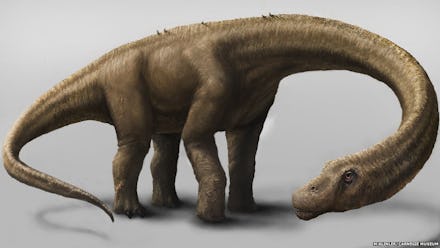This May Be the Largest Dinosaur Ever — And Scientists Have a Badass Name For It

The news: Meet Dreadnoughtus, your new prehistoric champion.
On Thursday, Nature published the results of a years-long excavation in Argentina, which may have unveiled the largest and heaviest dinosaur to ever walk on earth. Named Dreadnoughtus schrani – after the early 20th-century battleship — the dinosaur is estimated to have lived 77 million years ago.
According to calculations, Dreadnoughtus weighed around 65 tons and measured 85 feet long. If you want to get a sense of how ridiculously huge that is, that's heavier than an adult sperm whale or an entire herd of African elephants — and seven times the weight of a Tyrannosaurus rex, which is frankly unimpressive in comparison.
This is how big just the tail area is:
Why is it called Dreadnoughtus? Because, as researcher Matt Lamanna told ABC, "It was time a plant-eating dinosaur got a badass name. Those are usually reserved for the meat-eaters."
And lead researcher Kenneth Lacorava agrees. "Dreadnoughtus was huge, and in its environment there would have been nothing that could have preyed on it; it was essentially impervious to attack," he told the BBC. "And that evoked in my mind those turn-of-the-last-century battleships — the first really big steel battleships — that were also impervious to attack from the other ships that existed at that time. So, what better name than 'dread nought' - 'fears nothing.'"
This is a groundbreaking find in many ways. Another exciting thing about the Dreadnoughtus discovery, aside from its sheer size, is how remarkably well-preserved the fossil is. Since 2008, an international team of paleontologists has been excavating two specimens in Argentina, the larger of which constitutes the most fossil mass ever found of a single animal.
"For the [largest] dinosaurs, which we call titanosaurs, finding anything around 20% of the fossil is usually considered a home run," Lacovara explained. "Normally you only find a handful of bones, and the previous record was a 27% complete skeleton. With Dreadnoughtus we found 70%."
And because the fossil was so complete, it's giving paleontologists a much better idea of how these gigantic creatures actually lived and moved, which can be applied to creatures beyond the Dreadnoughtus.
The researchers have made free downloads of the detailed 3-D scans available here.